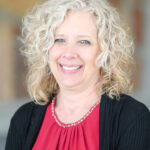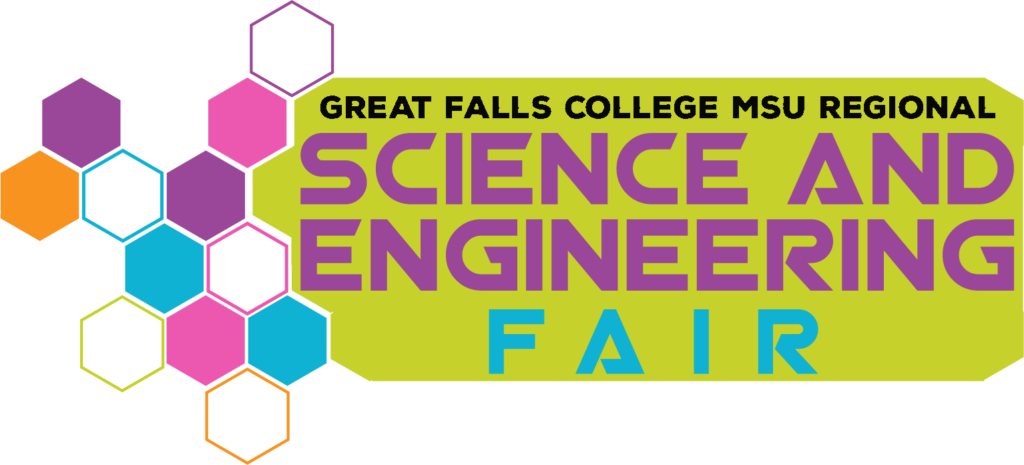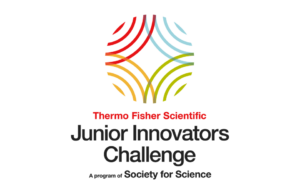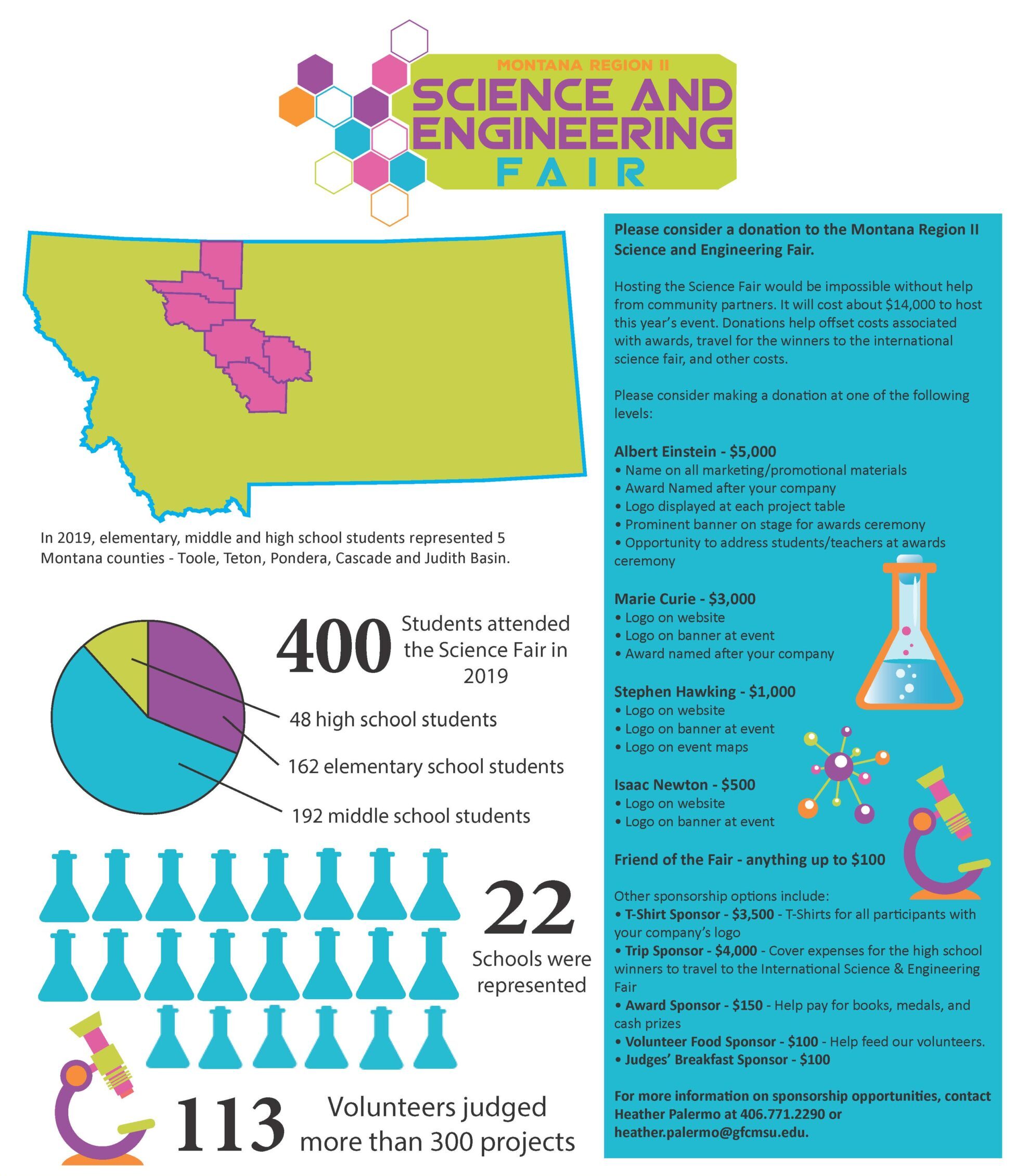Contact Information

Charla Merja
Director of Student CARE
Ph: (406) 771-4301
Location: G65 by the cafeteria.
Institutional Review Board
Leanne Frost, Ed.D.
Executive Director of Instruction
Brenda Canine, Ph.D.
Biology Faculty
Daniel Casmier, Ph.D.
Chemistry Faculty
Elfriede Neber, Ed.D
Behavioral Science Faculty
Russel Motschenbacher, M.S.N.
Nursing Program Director/Faculty
Scientific Review Committee
Leanne Frost, Ed.D.
Executive Director of Instruction
Brenda Canine, Ph.D.
Biology Faculty
Daniel Casmier, Ph.D.
Chemistry Faculty
Raimund Hahn, M.S.
Registered Professional Geologist
Need Project Support? Check out Dr. Baker’s Science for Kids.
Questions?

Check back for 2026 Science Fair Dates!
Project Rules
High School Rules
 The Great Falls College Regional Science & Engineering Fair is one of five regional science fairs in Montana and is affiliated with the Regeneron (ISEF). The top two grand award winners from the Great Falls College MSU Regional Science & Engineering Fair go on to compete at Regeneron ISEF.
The Great Falls College Regional Science & Engineering Fair is one of five regional science fairs in Montana and is affiliated with the Regeneron (ISEF). The top two grand award winners from the Great Falls College MSU Regional Science & Engineering Fair go on to compete at Regeneron ISEF.
Who Can Enter the Science & Engineering Fair Competition?
All students from grades 9-12 in our seven-county region are invited to enter the science fair competition. Students compete for trips, cash prizes, awards, and the ability to compete on the international stage. Full eligibility requirements may be found on the Student Society for Science website.
What You Need to Know Before Starting a Project
Before experimentation begins, the Great Falls College Regional Science & Engineering Fair Institutional Review Board (IRB) or Scientific Review Committee (SRC) must review and approve most projects involving human participants; vertebrate animals; potentially hazardous biological agents; and hazardous chemicals, activities, or devices.
Teams are limited to 3 members.
Note: If a project involves the testing of a student designed invention, prototype, or concept by a human, an IRB review and approval may be required prior to experimentation.
Please expect three to five working days for the local IRB/SRC to review your submission.
Please review the following ISEF Rules:
Submit your project Research Plan for review when you register for your fair. Below is a Sample Research Plan for your reference. If you have any IRB/SRC technical questions contact Leanne Frost at [email protected].
SEE FULL RULES BELOW.
High School Project Rules
All students are strongly encouraged to complete ISEF’s Rules Wizard to help determine what forms and approvals are necessary before beginning a science fair project. Visit the Student Society for Science website for a complete listing of the INTEL ISEF Rules & Guidelines and forms. The Great Falls College MSU Regional Science & Engineering Fair adheres to the ISEF Display and Safety Regulations.
Teams are limited to 3 members.
Students/teachers may also choose to review the forms below with links to the applicable forms. Please note: All projects involving Humans, Vertebrate Animals, or Potentially Hazardous Biological Agents (microorganisms, DNA, or Tissues) require prior approval by an SRC or IRB. If you have questions about the required ISEF paperwork, please submit your questions with a detailed research plan/protocol to: [email protected].
The Great Falls College Regional Science & Engineering Fair adheres to the ISEF Display and Safety Regulations.
Forms REQUIRED for all Projects:
Additional Forms if the Project involves:
1. Hazardous Chemicals, Activities, or Devices
OR
(see ISEF rules to determine appropriate form set)
2. Vertebrate Animals**
OR
(**Requires SRC or IRB approval PRIOR to experimentation; see ISEF rules to determine appropriate form set)
3. Human Subjects**
OR
(**Requires SRC or IRB approval PRIOR to experimentation; Documentation of written Informed Consent is required for most projects; see ISEF rules for additional information on risk assessment, informed consent, and the rules governing human research)
4. Potentially Hazardous Biological Agents**
Form 6B: Human and Vertebrate Animal Tissue Form (if applicable)
OR
Form 6B: Human and Vertebrate Animal Tissue Form (if applicable)
OR
(**Requires SRC or IRB approval PRIOR to experimentation; see ISEF rules to determine appropriate form set)
5) If the Project is a continuation from a previous year:
(In addition to all other relevant forms)
For projects involving Humans, Vertebrate Animals, or Potentially Hazardous Biological Agents (microorganisms, DNA, or Tissues), all applicable forms should be scanned and emailed to: [email protected].
Project Display Rules
Maximum Size of Project:
Depth (front to back): 30 inches
Width (side to side): 48 inches
Height (floor to top): 108 inches (assuming a table 36″ high)
In line with ISEF Safety Rules, displays at the fair may not include the following:
Living organisms, including plants
Glass
Soil, sand, rock, cement and/or waste samples, even if permanently encased in a slab of acrylic
Taxidermy specimens or parts
Preserved vertebrate or invertebrate animals
Human or animal food
Human/animal parts or body fluids (for example, blood, urine)
Plant materials (living, dead, or preserved) that are in their raw, unprocessed, or non-manufactured state
All chemicals including water. Absolutely no liquids can be utilized in the Project Display.
All hazardous substances or devices (Example: poisons, drugs, firearms, weapons, ammunition, reloading devices, grease/oil and sublimating solids such as dry ice)
Items that may have contained or been in contact with hazardous chemicals (Exception: Item may be permitted if professionally cleaned and document for such cleaning is available). Filters (including microbial) may not be displayed unless the Display & Safety Committee can reasonably determine that the device was cleaned or was never used (please include receipts in your notebooks and/or logbooks).
Sharp items (for example, syringes, needles, pipettes, knives)
Flames and highly flammable materials
Batteries with open-top cells or wet cells
Drones or any flight-capable apparatus unless the propulsion power source is removed
3D Printers unless the power source is removed
Inadequately insulated apparatus capable of producing dangerous temperatures are not permitted
Any apparatus with belts, pulleys, chains, or moving parts with tension or pinch points that are not appropriately shielded
Any display items that are deemed distracting (i.e. sounds, lights, odors, etc.)
Personal items or packaging materials stored underneath the booth
Any apparatus deemed unsafe by the Scientific Review Committee, the Display and Safety Committee, or Society for Science & the Public (Example: large vacuum tubes or dangerous ray-generating devices, empty tanks that previously contained combustible liquids or gases, pressurized tanks, etc.
Middle School Rules
 The Great Falls College Regional Science & Engineering Fair is affiliated with the Broadcom MASTERS Fair, a program of the Society for Science & the Public. BroadcomMASTERS (Math, Applied Science, Technology and Engineering Rising Stars), is the premier science and engineering competition for middle school students. The Region II Middle School Science Fair will nominate the top 10% of projects in the 6th, 7th, and 8th grades – both individual and team projects in biological and physical sciences to enter this prestigious competition. After submitting the online application, 300 semifinalists are selected, and 30 finalists present their research projects and compete in team hands-on STEM challenges to demonstrate their skills in critical thinking, collaboration, communication and creativity.
The Great Falls College Regional Science & Engineering Fair is affiliated with the Broadcom MASTERS Fair, a program of the Society for Science & the Public. BroadcomMASTERS (Math, Applied Science, Technology and Engineering Rising Stars), is the premier science and engineering competition for middle school students. The Region II Middle School Science Fair will nominate the top 10% of projects in the 6th, 7th, and 8th grades – both individual and team projects in biological and physical sciences to enter this prestigious competition. After submitting the online application, 300 semifinalists are selected, and 30 finalists present their research projects and compete in team hands-on STEM challenges to demonstrate their skills in critical thinking, collaboration, communication and creativity.
Who Can Enter the Middle School Science Fair Competition?
What You Need to Know Before Starting a Project
All students are strongly encouraged to complete ISEF’s Rules Wizard with a teacher or mentor before beginning a science fair project. Before experimentation begins, the Great Falls College Regional Science & Engineering Fair Institutional Review Board (IRB) or Scientific Review Committee (SRC) must review and approve most projects involving human participants; vertebrate animals; potentially hazardous biological agents; and hazardous chemicals, activities, or devices. Note: If a project involves the testing of a student designed invention, prototype, or concept by a human, an IRB review and approval may be required prior to experimentation. Please expect three to five working days for the local IRB/SRC to review your submission. Please review the following ISEF Rules:
Middle School Rules
Before experimentation begins, the Great Falls College MSU Regional Science & Engineering Fair Institutional Review Board (IRB) or Scientific Review Committee (SRC) must review and approve most projects involving human participants; vertebrate animals; potentially hazardous biological agents; and hazardous chemicals, activities, or devices. Submit the following form prior to project start: Assessment of Risk & Project Approval.
Project Display Rules
Maximum Size of Project:- Depth (front to back): 30 inches
- Width (side to side): 48 inches
- Height (floor to top): 108 inches (assuming a table 36″ high)
- Living organisms, including plants
- Glass
- Soil, sand, rock, cement and/or waste samples, even if permanently encased in a slab of acrylic
- Taxidermy specimens or parts
- Preserved vertebrate or invertebrate animals
- Human or animal food
- Human/animal parts or body fluids (for example, blood, urine)
- Plant materials (living, dead, or preserved) that are in their raw, unprocessed, or non-manufactured state
- All chemicals including water. Absolutely no liquids can be utilized in the Project Display.
- All hazardous substances or devices (Example: poisons, drugs, firearms, weapons, ammunition, reloading devices, grease/oil and sublimating solids such as dry ice)
- Items that may have contained or been in contact with hazardous chemicals (Exception: Item may be permitted if professionally cleaned and document for such cleaning is available). Filters (including microbial) may not be displayed unless the Display & Safety Committee can reasonably determine that the device was cleaned or was never used (please include receipts in your notebooks and/or logbooks).
- Sharp items (for example, syringes, needles, pipettes, knives)
- Flames and highly flammable materials
- Batteries with open-top cells or wet cells
- Drones or any flight-capable apparatus unless the propulsion power source is removed
- 3D Printers unless the power source is removed
- Inadequately insulated apparatus capable of producing dangerous temperatures are not permitted
- Any apparatus with belts, pulleys, chains, or moving parts with tension or pinch points that are not appropriately shielded
- Any display items that are deemed distracting (i.e. sounds, lights, odors, etc.)
- Personal items or packaging materials stored underneath the booth
- Any apparatus deemed unsafe by the Scientific Review Committee, the Display and Safety Committee, or Society for Science & the Public (Example: large vacuum tubes or dangerous ray-generating devices, empty tanks that previously contained combustible liquids or gases, pressurized tanks, etc.
Elementary School Rules
The 2025 Elementary Fair is scheduled for March 13.
Region II Elementary School Science Fair
Grades K-5
The Great Falls College MSU Regional Science & Engineering Fair allows students in grades K-5 to experience the competition of the science fair. The elementary school projects expose students to a broad range of scientific inquiry and give them the tools and knowledge needed to answer questions about the world around them. Student projects open the door to important concepts in physical and biological sciences.
Who Can Enter the Elementary School Science Fair Competition?
All students from grades K-5 in our seven-county region are invited to enter the science fair competition.
Elementary School Rules
Before experimentation begins, the Great Falls College MSU Regional Science & Engineering Fair Institutional Review Board (IRB) or Scientific Review Committee (SRC) must review and approve most projects involving human participants; vertebrate animals; potentially hazardous biological agents; and hazardous chemicals, activities, or devices.
Teams are limited to 3 members.
Submit the following form prior to project start: Elementary Assessment of Risk & Project Approval
Note: If a project involves the testing of a student designed invention, prototype, or concept by a human, an IRB review and approval may be required prior to experimentation.
Please expect three to five working days for the local IRB/SRC to review your submission.
Please review the following ISEF Rules:
- Human Participants
- Vertebrate Animals
- Potentially Hazardous Biological Agents
- Hazardous Chemicals, Activities, or Devices
Submit your project Research Plan for review when you register for your fair. Below is a Sample Research Plan for your reference. If you have any IRB/SRC technical questions, contact Leanne Frost at [email protected].
Project Display Rules
Maximum Size of Project:
- Depth (front to back): 30 inches
- Width (side to side): 48 inches
- Height (floor to top): 108 inches (assuming a table 36″ high)
Displays at the fair may include the following:
- Living organisms, including plants
- Glass
- Soil, sand, rock, and cement samples
- Taxidermy specimens or parts
- Preserved vertebrate or invertebrate animals
- Human or animal food
- Plant materials (living, dead, or preserved) that are in their raw, unprocessed, or non-manufactured state
- Any apparatus with belts, pulleys, chains, or moving parts with tension or pinch points that are appropriately shielded
- Personal items or packaging materials stored underneath the booth
Tips/Ideas for Elementary Science Fair Projects
There is a myriad of websites available to help students get started on their science fair projects. Below is just a small list of links. Explore!
| ||
| Kids Online Learning-Science, Technology & More! |
Schedule of Events
High & Middle School Schedule
2026 Science Fair Schedule coming soon
Elementary School Schedule
2026 Science Fair Schedule coming soon
Awards Criteria
High School Criteria
All Region II High School Science Fair projects will be judged using the following criteria:
The top two projects in the high school division will receive an all expense-paid trips to the 2023 Regeneron International Science and Engineering Fair to be held May 10-16, 2025 in Columbus, OH.
Merit Awards
Many professional and industrial organizations provide awards in the form of cash prizes, certificates of merit, medallions, plaques, ribbons, scholarships, and gift items.
Read over the awards list below paying special attention to the criteria and decide if you want to design your project with a special award in mind. If available, criteria for each is provided.
|
Middle School Criteria
All Region II Middle School Science Fair projects will be judged using the following criteria:
Merit Awards
Many professional and industrial organizations provide awards in the form of cash prizes, certificates of merit, medallions, plaques, ribbons, scholarships, and gift items.
Read over the awards list paying special attention to the criteria and decide if you want to design your project with a special award in mind.
Thermo Fisher Scientific Junior Innovators The Great Falls College Regional Middle School Science Fair is affiliated with the Thermo Fisher Scientific Junior Innovators Challenge a program of the Society for Science & the Public. Thermo Fisher Scientific JIC nominations are available to the top 10% of the estimated middle school (grades 6, 7, & 8) participants. Nominees complete the Thermo Fisher JIC online application. Entries are judged during the summer, and in early fall, the Top 300 students are named. From among the Top 300 , 30 students are selected as finalists and win an all-expense-paid trip to the national finals week in Washington, DC to showcase their projects, compete in teams and visit historical sites and organizations that celebrate innovation. The top prize is a $25,000 education award with numerous other awards and prizes offered throughout the process to both students and educators. Grades eligible: 6-8 |
Citizens for Clean Energy The Great Falls-based Citizens for Clean Energy organization (ccemontana.org) wishes to recognize science fair projects that focus on innovative renewable energy production and carbon emissions mitigation. Qualifying student projects may receive certificates and monetary awards of $40-$120. Students who wish to be considered for a CCE Merit Award are strongly encouraged to include wording in their project title or project description that identifies a clean energy or climate change solution theme. Grades eligible: 6-12 |
DoD STEM Leadership Prize Sponsored by the Department of Defense (DoD), the $100 “DoD STEM Leadership Prize” is given at 30 Broadcom MASTERS-affiliated middle school science fairs serving military-impacted areas in 2020. DoD STEM strives to grow a diverse pool of talented STEM professionals to meet the workforce needs of the future. The prize consists of a $100 award and a certificate acknowledging the middle school student or team demonstrates excellence in STEM, as well as the problem-solving skills and determination to overcome challenges throughout the research project. Grades eligible: 6-8 |
Lemelson Early Inventor Prize In partnership with The Lemelson Foundation, the Society for Science & the Public is offering a $100 prize to a 6th-8th grade inventor creating a promising solution to real-world problems. The award winner will: Grades eligible: 6-8 |
National Oceanic and Atmospheric Administration (NOAA) Awarded to the student whose research emphasizes NOAA’s mission of Science, Service, and Stewardship: “To understand and predict changes in climate, weather, oceans, and coasts, To share that knowledge and information with others, and To conserve and manage coastal and marine ecosystems and resources.” Grades eligible: 6-12 |
Naval Science Award (Individual Projects ONLY – Team Projects NOT Eligible) The Naval High School Science Awards Program (NSAP) is a U.S. Navy and Marine Corps program that encourages our nation’s students to develop and retain an interest in science and engineering. NSAP recognizes the accomplishments of eligible students at regional and state science and engineering fairs and the International Science and Engineering Fair (ISEF) in producing and presenting quality science and engineering projects. Grades eligible: 6-12 |
The following awards are given to project exhibiting outstanding merit in each field:
- Animal Science
- Behavioral Science
- Biochemistry
- Chemistry
- Computer Systems & Robotics
- Consumer Science
- Energy: Chemical/Physical
- Engineering
- Environmental
- Mathematics
- Medicine & Health
- Microbiology
- Physics & Astronomy
- Plant Science
Elementary School Criteria
All Region II Elementary Science Fair projects will be judged using the following criteria:
Merit Awards
The following awards are given to project exhibiting outstanding merit in each field:
- Consumer Science
- Earth & Space
- Engineering
- Health & Medicine
- Microbiology
- Most Creative
- Technology
Judge Information
Click on the links below to get more information on the 2025 Great Falls College MSU Reginal Science & Engineering Fair.
- Middle and High School Judges Schedule – March 11, 2025
- Elementary School Judges Schedule – March 13, 2025
Thank you to our Sponsors!
Your Impact

Support the Great Falls College Regional Science & Engineering Fair

